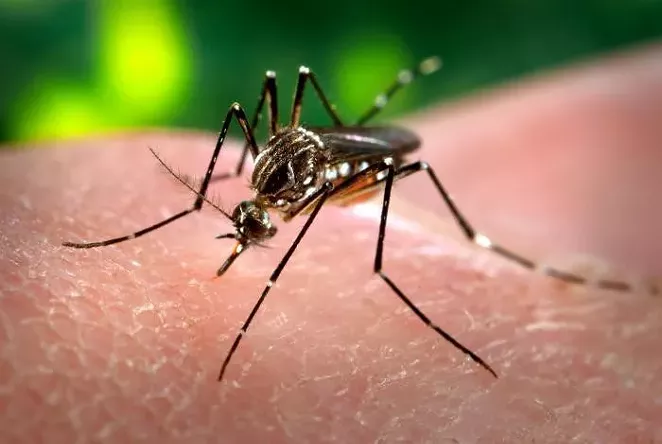Posted
By Greg Harman
on Wed, Aug 10, 2016 at 7:15 AM
 |
| Centers for Disease Control |
The
deadliest creatures on the planet
don’t consume their prey outright. They sip them. These stealthy meals
are hardly felt at all—until the itch sets in. Then you know: Mosquito.
Mosquito-borne diseases such as West Nile, chikungunya, and
Zika—strange-sounding and remote to most American ears—are given little
attention until they rush our shores to puncture our awareness in daily
headlines and newscasts.
Until the recent rise in reports of malformed babies started generating
low-grade panic in pockets of Texas and Florida and points in between,
these diminutive bloodsuckers had been relegated largely to mere “pest”
status. Sure there have been spikes of concern with the rise and fall of
each tropical virus, but we've ignored the constant generation of
potentially crippling new diseases beyond our borders.
Our circles of compassion too often collapse at national borders,
allowing entrenched killers like malaria to continue to claim the lives
of an estimated 600,000 men, women, and children (mostly children) every
year across the planet’s tropical belt.
Today's national Zika debates over how to fund a proper response have
stuck in the miasma of our polarized politics. Historically anemic
funding of mosquito surveillance and control efforts here in Texas have
left our political leaders discussing with straight faces how best to
distribute cans of bug spray to the most at risk.
But for those who think shrunken-headed babies is the worst it can get: Prepare to be overwhelmed.
The colluding forces of poverty, globalization, and climate change have
set the stage for a rapid cascading of public-health crises in the
United States, according to one of Texas’ leading experts on tropical
disease. In other words, as-yet-unrecognized nasties are already
preparing to displace incoming Zika from the top of our news cycle.
“We’re in for a long haul of new or old infectious epidemics that are
accelerating rapidly,” Dr. Peter Hotez, dean for the National School of
Tropical Medicine at the Baylor College of Medicine in Houston,
told Mark Goldberg on the “Global Dispatches” podcast earlier this year. “And we’re just not prepared.”
Thanks to human-caused climate change, epidemics of novel-sounding
viruses are likely to accelerate in Texas. In fact, the quickening is
already evident. Ten years after first showing its face in Texas, a West
Nile virus outbreak in 2012 resulted in an unprecedented 1,800
infections here, resulting in 89 deaths. These days, mosquito-control
yard signs staked into DFW lawns, where half of all 2012 cases occurred,
are hard to miss.
The halting reemergence of dengue, or “breakbone fever,” is again
badgering state residents, particularly in the Rio Grande Valley. During
a 2005 outbreak, the CDC estimates that one in three Brownsville-area
residents were exposed to the virus.
Sometimes mistaken for dengue in its manifestation in severe joint
pain, chikungunya (menacingly translated as: “to become contorted”)
started collecting its own domestic headlines in 2006 and 2007 and has
since been observed in most U.S. states, including Texas, though
exclusively as a travel-related import outside Florida—where Zika is
also now putting down roots.
For some time, climate change’s expansion of warmer, wetter tropical
weather across the U.S. South has been blamed for driving more tropical
disease our way. What has been missing from that analysis is
community-level research showing just how this may unfold.
That gap is beginning to be filled in thanks to the work of a Texas Tech University graduate student. As I wrote in detail for
Texas Climate News
recently, preliminary results from Kelly Neely’s work in buggy
Brownsville is demonstrating that potential disease carriers will
increase in Texas as the earth continues to warm.
That doesn’t necessarily translate into more infections; policy
responses could partially mitigate the threat. Support for the World
Health Organization’s
call for an international campaign
to fight neglected tropical diseases is vital, as is the reduction of
poverty both here and abroad that allows these killers to develop and
spread. At a federal and state level, it calls for ramping up
monitoring, prevention, and control measures.
Locally, individuals can do their part by eliminating backyard breeding habitat and patching those screen doors and windows.
More importantly, we need to do everything we can to check the
“neglected” disease march by acting aggressively to slow global warming.
Sure, we can keep the fossil-fuel throttle wide open and simply wait
for it to get too hot in Texas for the disease-carrying mosquitoes to
breed. We could reach that threshold this century, according to Neely.
That would unseat the stealthy mosquito. It could unseat us, as well.
Even after Texas' first Zika-related death this week in Houston—a child
struck with microcephaly—few are discussing Harris County's Executive
Director of Public Health Dr. Umar Shah’s admonition that this
potentially crippling wave of mosquito-borne illness is “not something
we can spray our way out of of.”
Poverty,
almost as much as the mosquitoes themselves and the warming climate
moving them deeper into the United States, is a key risk factor here in
San Antonio and around the world that few are willing to talk about.
Via
SACurrent.




